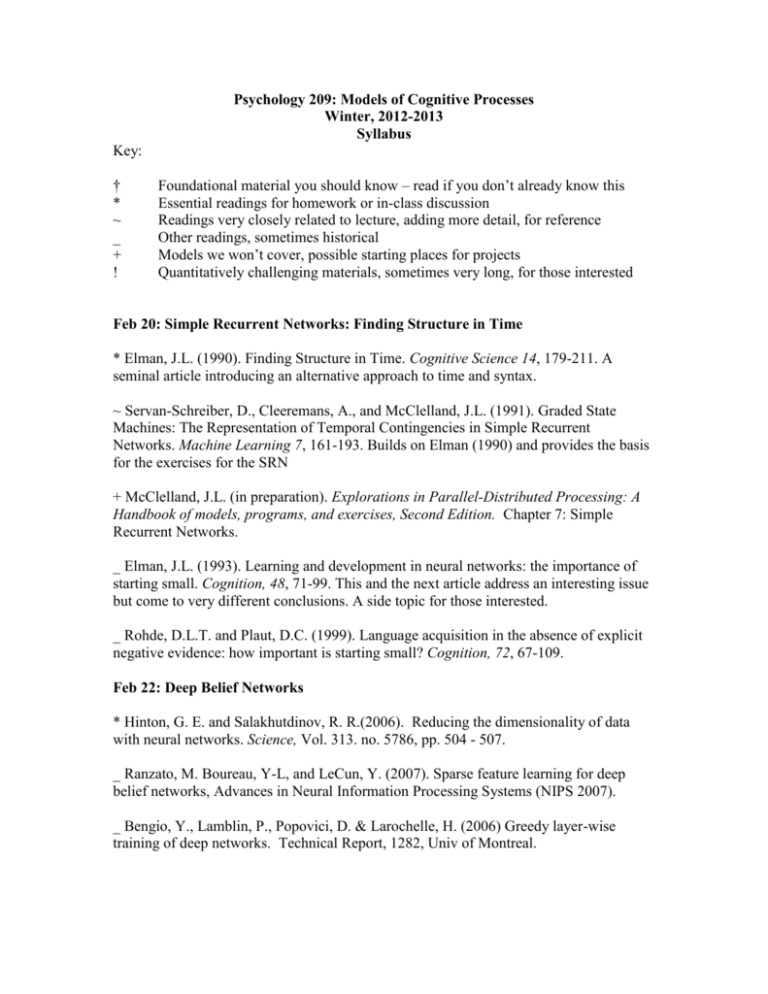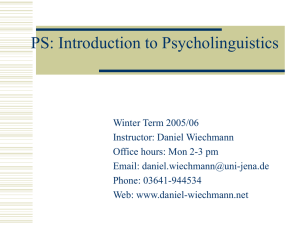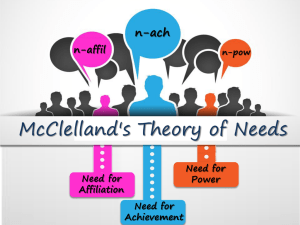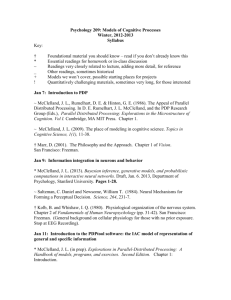Psych209RevisedSyllabus_13_02_20
advertisement

Psychology 209: Models of Cognitive Processes Winter, 2012-2013 Syllabus Key: † * ~ _ + ! Foundational material you should know – read if you don’t already know this Essential readings for homework or in-class discussion Readings very closely related to lecture, adding more detail, for reference Other readings, sometimes historical Models we won’t cover, possible starting places for projects Quantitatively challenging materials, sometimes very long, for those interested Feb 20: Simple Recurrent Networks: Finding Structure in Time * Elman, J.L. (1990). Finding Structure in Time. Cognitive Science 14, 179-211. A seminal article introducing an alternative approach to time and syntax. ~ Servan-Schreiber, D., Cleeremans, A., and McClelland, J.L. (1991). Graded State Machines: The Representation of Temporal Contingencies in Simple Recurrent Networks. Machine Learning 7, 161-193. Builds on Elman (1990) and provides the basis for the exercises for the SRN + McClelland, J.L. (in preparation). Explorations in Parallel-Distributed Processing: A Handbook of models, programs, and exercises, Second Edition. Chapter 7: Simple Recurrent Networks. _ Elman, J.L. (1993). Learning and development in neural networks: the importance of starting small. Cognition, 48, 71-99. This and the next article address an interesting issue but come to very different conclusions. A side topic for those interested. _ Rohde, D.L.T. and Plaut, D.C. (1999). Language acquisition in the absence of explicit negative evidence: how important is starting small? Cognition, 72, 67-109. Feb 22: Deep Belief Networks * Hinton, G. E. and Salakhutdinov, R. R.(2006). Reducing the dimensionality of data with neural networks. Science, Vol. 313. no. 5786, pp. 504 - 507. _ Ranzato, M. Boureau, Y-L, and LeCun, Y. (2007). Sparse feature learning for deep belief networks, Advances in Neural Information Processing Systems (NIPS 2007). _ Bengio, Y., Lamblin, P., Popovici, D. & Larochelle, H. (2006) Greedy layer-wise training of deep networks. Technical Report, 1282, Univ of Montreal. Feb 25: Learning in Recurrent Networks One-Page Project Proposals Due * Williams, R. J. and Zipser, D. (1995). Gradient-based learning algorithms for recurrent networks and their computational complexity. In: Y. Chauvin and D. E. Rumelhart (Eds.) Back-propagation: Theory, Architectures and Applications, Hillsdale, NJ: Erlbaum. ~ Movellan, J. R., & McClelland, J. L. (1993). Learning continuous probability distributions with symmetric diffusion networks. Cognitive Science, 17, 463-496. ~ O'Reilly, R.C. (1996). Biologically Plausible Error-driven Learning using Local Activation Differences: The Generalized Recirculation Algorithm. Neural Computation, 8, 895-938. + McClelland, J.L. (in preparation). Explorations in Parallel-Distributed Processing: A Handbook of models, programs, and exercises, Second Edition. Chapter 8: Recurrent Backpropagation. Feb 27: Reinforcement Learning */+ McClelland, J.L. (in preparation). Explorations in Parallel-Distributed Processing: A Handbook of models, programs, and exercises, Second Edition. Chapter 9: Temporal Difference Learning. Mar 1: Efficient Sensory Coding * Olshausen, B. A. and Field, D. (2004). Sparse coding of sensory inputs. Current Opinion in Neurobiology, 14:481-487. ~ Smith, E. C. & Lewicki, M. J. (2006). Efficient auditory coding. Nature, 439, 978-982. ~ Karklin, Y., and Lewicki, M. S. Emergence of complex cell properties by learning to generalize in natural scenes. Nature, 457, 83-86. Mar 4: Dynamics of Decision Making * Bogacz,R., Usher, M., Zhang, J. & McClelland, J. L. (2012). Extending a biologically inspired model of choice: multi-alternatives, nonlinearity and value-based multidimensional choice. In A. K. Seth, T. J. Prescott and J. J. Bryson (Eds.), Modelling Natural Action Selection. pp 91-119. Cambridge, UK: Cambridge University Press. ~ Gold, J. I. and Shadlen, M. N. The Neural Basis of Decision Making. Annual Review of Neuroscience, 30, 535-574 ! Wong, K.F. and Wang, X.J. A recurrent network mechanism of time integration in perceptual decisions. Journal of Neuroscience, 26, 1314-1328. Very interesting because it links from detailed neuronal models to behavior. The on-line supplement is also available in the class readings directory for those who are interested. ! Bogacz, R., Brown, E., Moehlis, J., Holmes, P., & Cohen, J.D. (2006). The physics of optimal decision making: A formal analysis of models of performance in two-alternative forced choice tasks. Psychological Review, 113, 700-65. This is a very technical paper and is provided only for those interested. Feb 6: Executive functions and attention * Cohen, J. D., Dunbar, K. and McClelland, J. L. (1990). On the Control of Automatic Processes: A Parallel-Distributed Processing Account of the Stroop Effect. Psychological Review, 97, 332-361. ~ Botvinick, M. and Plaut, D. C. (2004). Doing without schema hierarchies: A recurrent connectionist approach to normal and impaired routine sequential action. Psychological Review, 111, 395-429. ~ Moody, S. L., Wise, S. P., di Pellegrino, G., & Zipser, D. (1998). A model that accounts for activity in primate frontal cortex during a delayed matching-to-sample task. The Journal of Neuroscience, 18 (1), 399-410. _ Cohen, J. D., Servan-Schreiber, D., & McClelland, J. L. (1992). A parallel distributed processing approach to automaticity. American Journal of Psychology, 105, 239-269. _ Miller, E. K. and Cohen, J. D. (2001). An Integrative Theory of Prefrontal Cortex Function. Annual Review of Neuroscience, 24, 167-202. March 8: The Binding Problem and Complementary Object processing systems in Dorsal and Ventral Cortex Lecture by Cynthia Henderson * Henderson, C. M. & McClelland, J. L. (2011). A PDP model of the simultaneous perception of multiple objects. Connection Science, 23, 161-172. Readings to be determined Mar 11, 13, 15: Project Presentations Mar 20, 5:00 pm. Final Project Due Topics Not Covered Topic A: Connectionist Approaches to Language Processing * Elman, J. L. (2009). On the meaning of words and dinosaur bones: Lexical knowledge without a lexicon. Cognitive Science. 33(4), 547–582. ~ McClelland, J.L., St. John, M., and Taraban, R. (1989). Sentence Comprehension: A Parallel Distributed Processing Approach. Language and Cognitive Processes, 4, 287335. _ Rohde, D.L.T. (1999). A Connectionist Model of Sentence Comprehension and Production. Unpublished PhD thesis proposal, School of Computer Science, Carnegie Mellon University, Pittsburgh, PA. _ Tabor, W., Juliano, C., & Tanenhaus, M. K. (1997). Parsing in a dynamical system: An attractor-based account of the interaction of lexical and structural constraints in sentence processing. Language and Cognitive Processes, 12, 211-271. Topic B: Disorders of Lexical and Semantic Processing * Dilkina, K., McClelland, J. L. & Plaut, D. C. (2008). A single-system account of semantic and lexical deficits in five semantic dementia patients. Cognitive Neuropsychology, 25(2), 136-164. _ Rogers, T. T., Lambon Ralph, M. A., Garrard, P., Bozeat, S., McClelland, J. L., Hodges, J. R., and Patterson, K. (2004). The structure and deterioration of semantic memory: A neuropsychological and computational investigation. Psychological Review, 111, 205-235. _ Plaut, D. C. and Shallice, T. (1993). Deep dyslexia: A case study of connectionist neuropsychology. Cognitive Neuropsychology, 10, 377-500. _ Plaut, D. C., McClelland, J. L., Seidenberg, M. S., and Patterson, K. (1996). Understanding normal and impaired word reading: Computational principles in quasiregular domains. Psychological Review, 103, 56-115.











